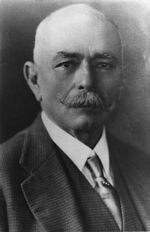Higher value notes of Miguel and Ignacio Cornejo
At the time of the Mexican revolution the peninsula of Baja California was divided administratively into two territories. In the south the Huertista General Gregorio Osuna held out until he evacuated La Paz in March 1914 and the Constitutionalists moved in. There the need for currency to pay troops and facilitate commerce was greater and on 21 August 1914 the jefe político of southern Baja California, Miguel Cornejo, acting on an authorization that he had received on 30 April from General Alvaro Obregón, as chief of the Ejército del Noroeste, authorized an issue of notes in three denominations (five, ten and twenty pesos)[text needed].
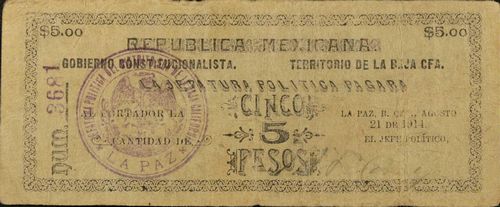
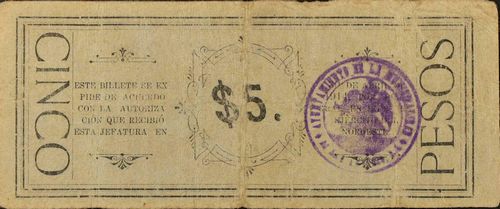
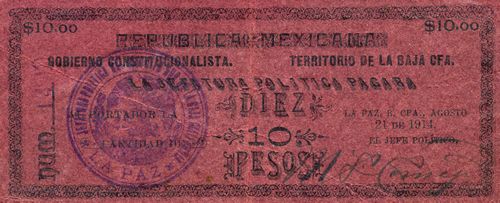
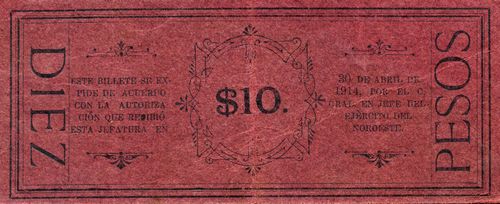
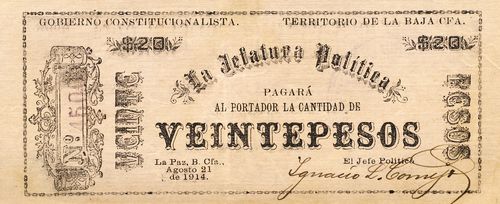
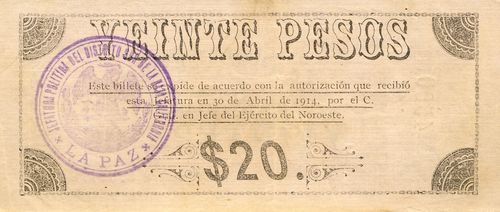
| from | to | total number |
total value |
||
| $5 | 0001 | includes numbers 0210 to 5534 | |||
| $10 | 0001 | includes numbers 0590CNBanxico #5329 to 1400 | |||
| $20 | 0001 | signed by Miguel Cornejo | |||
| signed by Ignacio Cornejo includes numbers 1455CNBanxico #5330 to 5523CNBanxico #11 |
These are signed by either Miguel or Ignacio Cornejo.
Some are known with a resello 'AYUNTAMIENTO DE LA MUNICIPALIDAD DE SAN ANTONIO, B. C.'.
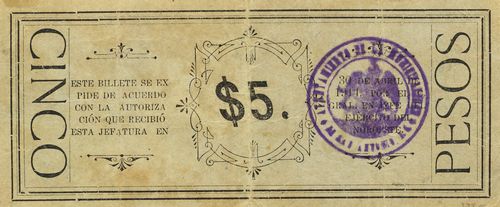
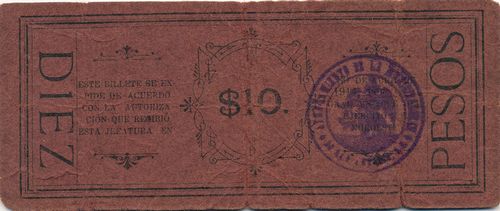
Carranza specifically confirmed the legitimacy of this issue when he wrote to Miguel Cornejo from Mexico City on 5 September telling him that he could continue issuing obligaciones to cover his costs until they could be exchanged for notes (Puede usted seguir emitiendo obligaciones para cubrir haberes mientras se le mandan billetes para ser canjeados). In all matters, military and political, Cornejo was to obey only Carranza himself or ObregónBoletín Oficial, Gobierno Constitucionalista de México, La Paz, 21 September 1914. Note that Cornejo's successor, Félix Ortega, in his manifesto, distinguished between issuing paper money and issuing obligaciones to state employees.
On 9 February 1915 General Brigadier Félix Ortega, the new jefe político, decreed (decree núm. 1) that these Cornejo notes were null and worthless. Annulling the Cornejo notes caused upset in La Paz and the town council (which included the leading businessmen) told Ortega that his decree would be severely detrimental because the lack of funds would means people could not buy necessities and small businesses would grind to a halt. Ortega replied that the decree was intended to avoid the economic isolation of the territory as the Cornejo notes were not accepted on the mainland opposite and that he was attempting to put into circulation a currency that would be accepted in Sonora, Sinaloa and Tepic. He added that holders of large quantities of Cornejo notes could exchange them over time for notes of general circulation (such as the sábanas and dos caritas of Chihuahua, and the issues of Sinaloa’s Riveros and the Estado de Sonora issue. Besides, the lower value cartones with the Jefatura’s resello still remained in circulation to facilitate day-to-day transactions. Finally, troops and public employees were being paid with notes of general circulation, so these would be available.
On 11 February the Presidente Municipal Interino of Todos Santos, Valente Salgado, published Ortega’s decree, as soon as he received it but asked what to do with the $450 in such notes in the Tesorería and was told to hold on to themABCS, Gobernación, vol. 642, exp. 150.
In correspondence and meetings over the next few weeks there is mention of withdrawing the local paper currency, but this seems to refer to the local vales rather then this Cornejo issue, which seems to have just lost its value. However, a week after the Carrancista Urbano Angulo took over, on 13 July 1915 he wrote to Coronel José J. Obregón, in charge in Mazatlán, that the merchants in La Paz could not trade with Sinaloa because they lacked the requisite paper money and so Angulo thought it convenient to send various sizeable packets of Cornejo currency in the hope that they could be exchanged so that the public in La Paz could acquire basic necessitiesABCS, Gobernación, vol. 646bis, exp. 63. The amounts sent over, totalling $30,455, wereABCS, Gobernación, vol. 647 2.2, exp. 46
| Oficio | amount | remitted by | sum to be collected by | ||
| 27 | $12,000 | González e hijos | Melchers Sucrs | ||
| 32 | 2,955 | Felipe R. Cota | Melchers Sucrs | ||
| 35 | 10,000 | Antonio Ruffo | Wohler Bartning, Sucrs. | ||
| 37 | 2,500 | Eduardo S. Carrillo | Adolfo Labastida | ||
| 39 | 3,000 | Quong Ley Yuen y Cía. | Mauel Yuen |
A $5 note is known with two resellos of the Distrito de Mazatlán and a stamp 'Retirado de la Circ'[image needed].
When, on [ ], Crispín Rodas y A. rose in favour of Villa, he decreed[text needed] that people had to accept the Cornejo notes.
When Ortega’s decree núm. 1 invalidated the Cornejo notes the French doctor V. Lacavalerie was left holding $865 of them and thus unable to buy medicine from the StatesABCS, Gobernación, vol. 642, exp. 150.
A year later, on 31 January 1916 the Comandante Militar, Urbano Angulo, wrote to Carranza that holders of Cornejo notes were asking if they were valid, and so he asked for a decisionABCS, Hacienda, vol. 658 1/2, exp. 50. Carranza replied on 3 February that his Primera Jefatura had not authorised the issueABCS, Gobernación, vol. 658 2/2, exp.189 whereupon Angulo had to remind Carranza that in September 1914 Cornejo had published Carranza’s message authorising the issueMéxico Palacio Nacional. El 15 de Septiembre de 1914. La Paz. – M. L. Cornejo, Jefe Político. – Puede Ud seguir emitiendo obligaciones para cubrir haberes mientras se le mandan billetes para ser canjeados. – Tanto en asunto militares – como políticos de esa península unicamente atenderá Ud. ordenes de esta Primera Jefatura y del Gral Obregón Jefe del Ejército del noroeste. – V. Carranza. (ABCS, Gobernación, vol. 658 2/2, exp.189).

